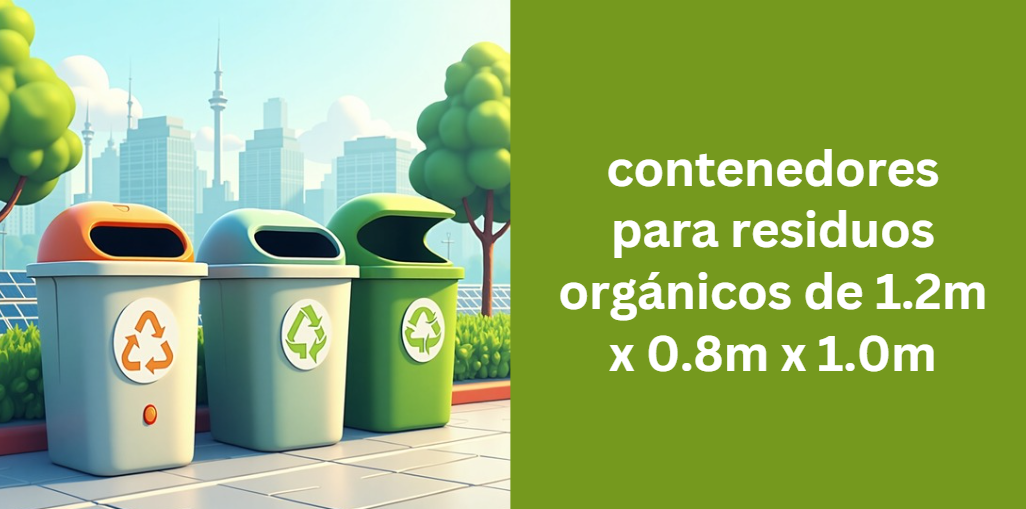The Ultimate Guide to contenedores para residuos orgánicos de 1.2m x 0.8m x 1.0m
The effective management of organic waste plays a vital role in reducing landfill use, lowering greenhouse gas emissions, and promoting composting. Contenedores para residuos orgánicos de 1.2m x 0.8m x 1.0m have been developed to address the unique challenges associated with handling biodegradable materials.
These containers are engineered with a precise capacity and robust construction to support urban and rural waste management systems alike. By understanding the features and benefits of these containers, municipalities, businesses, and homeowners can enhance sustainability and improve the efficiency of their waste segregation programs.
Background on Organic Waste Management
Over the years, waste management practices have evolved significantly, with a growing emphasis on separating organic waste from other types of refuse. Historically, organic waste was mixed with general garbage, contributing to increased landfill volumes and higher methane emissions. Today, the separation and proper treatment of biodegradable materials have become priorities for many governments and environmental organizations.
The integration of specialized containers, such as contenedores para residuos orgánicos de 1.2m x 0.8m x 1.0m, supports these modern practices by offering tailored solutions that facilitate recycling and composting while ensuring operational efficiency.
Technical Specifications and Design Features
Detailed Dimensions and Capacity
The dimensions of contenedores para residuos orgánicos de 1.2m x 0.8m x 1.0m are carefully chosen to offer optimal capacity while fitting into a variety of spaces. With a length of 1.2 meters, a width of 0.8 meters, and a height of 1.0 meter, these containers provide a balanced storage solution for organic waste.
This size is ideal for both small communities and larger municipal operations, ensuring that enough waste can be collected without the need for excessively large units. The following table summarizes the key specifications:
| Specification | Measurement |
|---|---|
| Length | 1.2 meters |
| Width | 0.8 meters |
| Height | 1.0 meter |
| Capacity | Designed for moderate organic waste loads |
Materials and Construction
Constructed with durability in mind, these containers are typically made from high-density polyethylene (HDPE) or weather-resistant metals. Such materials provide longevity and resistance to corrosion, which is essential when dealing with organic materials that can be both acidic and moist.
The design includes features like tight-fitting lids to control odors, integrated ventilation systems to balance airflow, and ergonomic handles or wheels that simplify transportation and placement. These characteristics ensure that contenedores para residuos orgánicos de 1.2m x 0.8m x 1.0m are not only functional but also cost-effective over their lifecycle.
Benefits and Advantages
The implementation of contenedores para residuos orgánicos de 1.2m x 0.8m x 1.0m offers several significant benefits that extend beyond simple waste collection. First, these containers promote efficient waste segregation, which in turn enhances recycling and composting efforts. By isolating organic waste, communities can reduce the volume of material sent to landfills and lower greenhouse gas emissions from decomposing waste. In addition, their robust design minimizes maintenance costs and increases operational efficiency.
Furthermore, the controlled environment provided by these containers helps mitigate odor issues and prevents pests, contributing to improved public health and urban aesthetics. For municipalities and businesses, the use of standardized containers simplifies logistics and reduces the complexity of waste management systems, leading to both environmental and economic advantages.
Installation and Maintenance Guidelines
Installing and maintaining contenedores para residuos orgánicos de 1.2m x 0.8m x 1.0m is straightforward, but proper procedures must be followed to ensure longevity and optimal performance. When installing, careful consideration should be given to location—ensuring easy accessibility for waste collection vehicles and minimizing the impact on pedestrian and vehicular traffic. The containers should be placed on stable surfaces and, if needed, anchored securely to prevent movement during collection.
Maintenance is critical for hygiene and durability. A routine maintenance schedule should include periodic cleaning with disinfectants, regular inspection of the lid and seals for any damage, and checks on the wheels and handles to ensure smooth operation. For example, a simple maintenance checklist might involve:
- Monthly inspection for cracks or signs of wear.
- Cleaning the interior with appropriate cleaning agents.
- Verifying the integrity of the lids and seals.
- Ensuring that all mechanical parts, such as wheels, function correctly.
Regulatory Standards and Best Practices
Adhering to local and international regulatory guidelines is essential when deploying contenedores para residuos orgánicos de 1.2m x 0.8m x 1.0m. These standards are designed to ensure that waste management systems are both safe and environmentally friendly. Municipalities typically follow guidelines set forth by environmental agencies, which specify requirements for container materials, dimensions, and placement. By complying with these regulations, users can ensure that their waste management practices are both legal and effective.
In addition to regulatory compliance, following best practices in container placement and usage can further optimize waste collection. For instance, positioning containers in high-traffic areas where organic waste is most likely to be generated can significantly improve collection efficiency and reduce operational costs.
Case Studies and Success Stories
Real-world implementations of contenedores para residuos orgánicos de 1.2m x 0.8m x 1.0m have demonstrated their effectiveness in improving organic waste management. In several municipalities, the adoption of these containers has led to a measurable decrease in landfill volumes and enhanced rates of composting. One notable case involved a medium-sized city that integrated these containers into its public waste management system, resulting in a 30% increase in organic waste recycling and a substantial reduction in odor complaints.
An infographic illustrating key performance indicators—such as waste reduction, collection efficiency, and cost savings—can help visualize the success of these initiatives and serve as a practical example for other communities considering similar solutions.
Future Trends and Innovations
Looking ahead, the field of organic waste management is poised for further innovation. Emerging trends include the integration of sensor technology for real-time monitoring of container fill levels, which can lead to more efficient waste collection routes and reduced operational costs. Additionally, advancements in materials science may lead to even more durable and lightweight containers that offer improved resistance to environmental factors.
As smart city initiatives continue to evolve, contenedores para residuos orgánicos de 1.2m x 0.8m x 1.0m are likely to become an integral component of interconnected urban waste management systems. Innovations such as automated alerts and data analytics will enable more precise planning and execution, driving further improvements in sustainability and efficiency.
Frequently Asked Questions (FAQs)
How long can one expect these containers to last under normal operating conditions?
The expected operational lifespan of contenedores para residuos orgánicos de 1.2m x 0.8m x 1.0m depends largely on the materials used and the local environmental conditions. For instance, containers made from high-density polyethylene (HDPE) or weather-treated metal typically have a lifespan of several years when maintained properly. Regular cleaning and routine inspections can extend their durability. Although factors like heavy UV exposure or extreme weather can shorten this life, a well-maintained container can remain functional and efficient over a long period, offering excellent long-term cost-effectiveness.
Is it possible to customize these containers for specific municipal or corporate needs?
Yes, customization is a viable option with contenedores para residuos orgánicos de 1.2m x 0.8m x 1.0m. Municipalities and companies often have unique branding or functional requirements, and these containers can be adapted in terms of color, signage, and even integrated sensor systems. Custom logos, color schemes, or additional compartments can be added to meet the specific demands of different users, making them not only functional but also visually aligned with the brand or local community standards.
In what ways do these containers contribute to local economic growth and job creation?
Deploying contenedores para residuos orgánicos de 1.2m x 0.8m x 1.0m supports local economies by creating opportunities in installation, maintenance, and waste collection services. The manufacturing, distribution, and regular upkeep of these containers often require skilled labor, which can stimulate job growth. Moreover, efficient waste management systems help lower municipal costs and support local recycling and composting industries, thereby fostering broader economic benefits within communities.
What are the best practices for recycling or disposing of these containers at the end of their lifecycle?
At the end of their service life, contenedores para residuos orgánicos de 1.2m x 0.8m x 1.0m can be recycled, provided they are made from recyclable materials like HDPE or certain treated metals. It is recommended to follow local waste management guidelines for disposal, which might include specialized recycling programs for industrial plastics or metals. Proper decommissioning not only helps in reducing landfill waste but also contributes to the circular economy by ensuring that valuable materials are reused.
How do these containers compare with alternative waste management solutions regarding energy efficiency and carbon footprint?
When compared with other waste management solutions, contenedores para residuos orgánicos de 1.2m x 0.8m x 1.0m are designed with energy efficiency in mind. Their standardized design allows for optimal space utilization and reduces the need for excessive collection runs, thereby lowering overall fuel consumption and carbon emissions. Moreover, using durable and recyclable materials contributes to a lower environmental impact over the container’s life cycle. This makes them a sustainable choice in urban waste management strategies.
Conclusion
In summary, this guide has provided an in-depth exploration of contenedores para residuos orgánicos de 1.2m x 0.8m x 1.0m, covering everything from design and technical specifications to installation, maintenance, and environmental impact. These containers represent a crucial element in modern organic waste management, offering efficiency, durability, and compliance with regulatory standards. By understanding their benefits and proper usage, municipalities, businesses, and communities can significantly enhance their waste management systems while promoting sustainability.
This comprehensive resource is designed to equip you with all the information necessary to make informed decisions about adopting these containers, ensuring a cleaner, greener future through optimized waste management practices.
Recommended posts
The Ultimate Guide to JLDQ.19B.306.149D01: Specifications, Applications, and Installation
Comprehensive Guide to mygreenbucks kenneth jone
Complete Guide to the Nuvita Corsync Scale Manual
Swatapp.me المانجا – The Ultimate Guide to Reading Manga Online
Auggie Savage: The Complete Biography, Family, and Life Story
Blog MobileCreativeOrg – The Ultimate Guide to Mobile Creativity & Innovation




